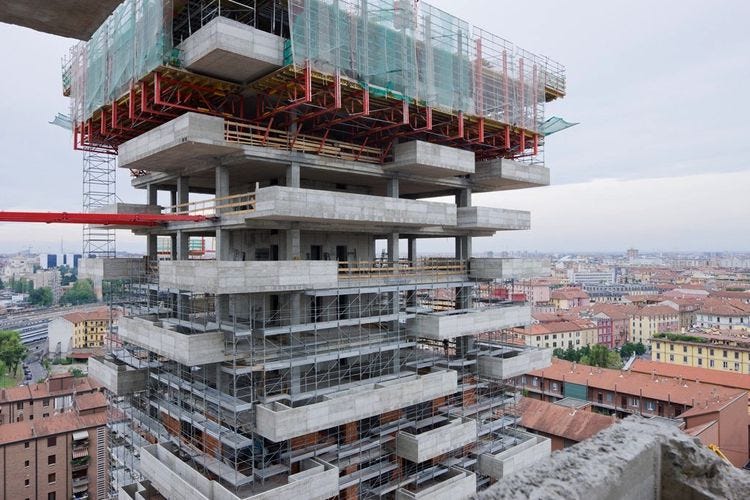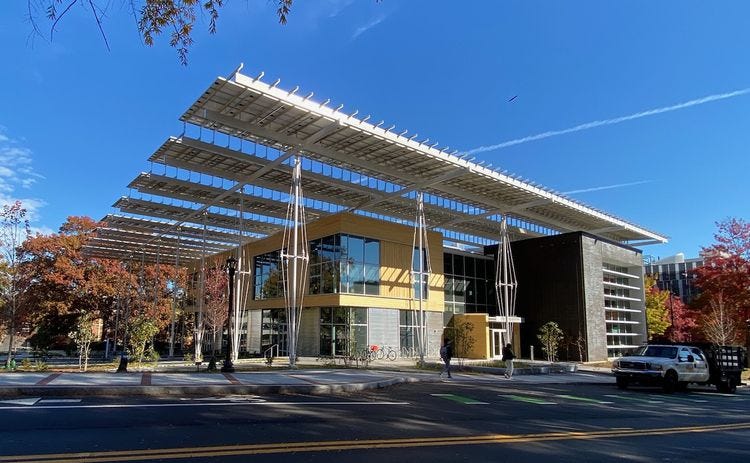Sustainable design is dead, long live regenerative design!
But first we have to figure out what it is, and it is more than just plopping trees on roofs.
Enter “regenerative design” into the Google and you will get a full page of photos of the Bosco Verticale in Milan, Stefano Boeri’s marvellous tree-covered condo. It’s in 11 of the first 15 images; the other four are also big concrete buildings covered with trees.
But look at the concrete cantilevering out to support those planters. If one of the virtues of all those trees is that they absorb carbon dioxide, how long will it take to pay off the carbon debt of building their planters and decks? Does plopping a tree on a roof make a building regenerative when you take into account the structural gymnastics necessary to hold it up? No, this is neither sustainable nor regenerative, there has to be more than this.
There is no question that we have to move beyond “sustainable design,” which comes down to just trying to not make things worse. As Bill McDonough said in his famous and oft repeated joke, “what would your wife think if you said, “our marriage is sustainable.” Is that enough? No, we want to make things better! I wanted a better name for my “sustainable design” class at Toronto Metropolitan University and asked my students all to come up with something, and Regenerative Design definitely won (though I liked “Death by Design.”) But what is it?
The UK Architects Declare gang recently came up with their Regenerative Design Primer, a guide for architectural firms. They listed with three ways that it transcends sustainable design:
From being ‘less bad’ to being net positive.
From being just focussed on humans to considering the whole web of life.
From a mechanistic approach that can focus too exclusively on carbon (sometimes referred to as ‘carbon reductivism’) to a more holistic and systemic approach.
In my writing and teaching I have definitely fallen into carbon reductivism, believing it is such an important point that I have to keep hammering at it. But were I actually designing a building, there is no question that one has to get past it.
AD also makes a great table with three columns labelled “I don’t care” (business as usual) “I do care, but…” (sustainable design) and “I really care!” (regenerative design). When creating spaces for people:
The scheme produces more energy than it consumes, may sequester carbon instead of emitting it and could create jobs and value for all. It gives back to the wider system.
Energy is derived from natural energy flows and sources of waste heat have been incorporated into the energy strategy.
Materials are selected and sourced more locally, aiming to use biobased and waste materials, with buildings seen as carbon sinks.
Nothing here about plopping trees on roofs. But they go on about co-evolving with nature:
The development has been designed to enhance and protect biodiversity creating a space that coevolves with nature and creates more indigenous habitats.
They also get into the plumbing, noting:
The complete water cycle has been investigated and nature-based solutions utilised so that rain and wastewater are treated and stored onsite.
This is something that we have to take far more seriously. We have just been flushing this all away for a century, and it is coming back to bite us all with the massive flooding happening in so many places, including my home Toronto.
British structural engineers didn’t want to miss this boat, and Robin Jones’s workshop for the Institution of Structural Engineers came up with four interesting principles:
Systems thinking is crucial: designers and stakeholders need to think holistically beyond the boundary of the construction site (the ‘red line’) to understand the wider impact of designs on natureand society, both geographicallyand over time.
Positive feedback loops need to be created: construction must become an act of long-term healing, creating lasting, resilient and self-sustaining positive interventions in the systems above.
Projects should enable nature and society to thrive: the guiding outcome must be to ‘do more good’ rather than following the ‘do less harm’ approach promoted by conventional sustainability practices.
Design should be place-based: designers must respond to the project location, the perspectives and socio-economic needs of the local community, and availability of local materials. This likely means a change from linear mass production of materials, to tailored design with a reduced reliance on long, opaque, unfair and fragile supply chains.
The key point in the whole thing is to have “a more holistic and systemic approach.” to “think holistically beyond the boundary of the construction site.” To paraphrase John Donne,
No man building is an island, Entire of itself; Every man building is a piece of the continent, A part of the main.
And seriously people, stop showing photos of buildings with trees on top when you are talking about regenerative design. Show instead Architype’s Enterprise Centre, “clad in Norfolk thatch and reed, while other material choices included 100% recycled paper insulation, hemp fabric, reprocessed glass, clay plaster and nettle boards. Biodiversity features within the building include insect hotels, bat and bird boxes and display bed terraces.”
Or the Kendeda Center in Atlanta, where the architects, Miller Hull, described regenerative design:
“Since the Industrial Revolution, humans have degraded natural environments – to the point where our activities are impacting the entire world today in what’s known as the Anthropocene Era. Our climate is changing, species are going extinct at an accelerating pace, forests are being lost to agriculture and sprawl at record rates, our trash litters every corner of the planet, and hazardous chemicals are ubiquitous. Regenerative design moves well beyond mere sustainability, setting a goal to restore or regenerate the natural systems we all depend upon to live. It is a practice that merges building design with the surrounding natural environment.”
As for my students’ suggestions for a new name for the class (including the last one, “we are doomed,”) the chair of my department told me that any new name would have to be approved by the Governing Council of the University and would take about three years. Change is hard.












Oddly, I did almost the same thing for a recent talk, starting with googling ‘sustainable building’, and got a virtually identical set of images (no way to insert it here): all exteriors with massive amounts of greenery on them. Nothing showing other aspects of sustainable design. In other words, superficial.
And I’ve been working up a post on the language of environmentalism generally, looking at some of our fundamental terms, many of which are problematic. Regenerative design is a decent candidate to replace sustainable design for all the reasons you mentioned, and I currently use it to describe the next level of thinking after sustainable design and systems thinking (in the evolution of environmentalism from 3Rs to Cradle to Grave to Cradle to Cradle (life cycle) to Sustainability to Systems Thinking to Regenerative). But I think it still doesn’t hit the spot, partially because regeneration is an unfamiliar and unrelatable word for most people.
And it needs to be something positive and enticing as well as easily grasped. Something that addresses McDonough’s point and incorporates flourishing or thriving. I’m workshopping some ideas but am not there yet.
I enjoyed reading this as I have thought about trees on buildings often. Thank you Lloyd.
I have nothing against trees on top of, inside or on balconies of any building, but calling a building Regenerative for only that reason is a bit superficial and lazy. That said, I think we stand to see commodification of "Regenerative Design" very soon as well. We have seen it with Sustainability and Carbon or Energy Neutral Design before. I mean most of these phrases are now used as green washing old building methods with a bit of trees on the top or sometimes photovoltaic cells. We need to address the linguistic consumption for profit as well. As soon as a phrase is defined and embraced by great intentions, the commodification begins. Now, Shell, Exxon, and BP are in Carbon reduction business!